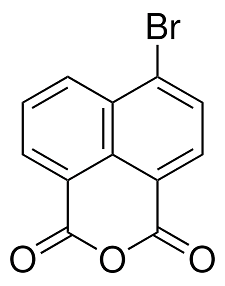HI! I’M ELEMENT AI.
4-Bromo-1,8-Naphthalic Anhydride

Product Description
4-Bromo-1,8-naphthalic anhydride is a chemical compound with several industrial applications.
Product:
4-Bromo-1,8-Naphthalic Anhydride
CAS:
81-86-7
Synonym:
4-Bromonaphthalic anhydride
Structure:

Typical Characteristics
Appearance
Off-White to Pale Yellow powder
Density
1.812 g/cm3
Melting point
217-219 °C
Molecular Weight
277.07
Purity
95%
Uses, Applications & Markets
Key applications
get a quote
We Offer 4-Bromo-1,8-Naphthalic Anhydride
in various grades
A few of the grades available are listed below:



4-Bromo-1,8-Naphthalic Anhydride used in many
industry applications
4-Bromo-1,8-naphthalic anhydride is a chemical compound with several industrial applications. Here are some of its main uses:
- Chemical Synthesis: This compound serves as a versatile building block in organic synthesis reactions, allowing for the preparation of various functionalized naphthalene derivatives. It can be employed in the synthesis of pharmaceutical intermediates, agrochemicals, and fine chemicals.
- Dye Intermediates: 4-Bromo-1,8-naphthalic anhydride is utilized as a precursor in the synthesis of dyes and pigments, particularly those with naphthalene-based chromophores. It serves as a key intermediate in the production of colorants used in textiles, printing inks, paints, and plastics.
- Photographic Chemicals: This compound has historical significance in the field of photography as a component of developer solutions. It can aid in the reduction of silver halide crystals to metallic silver during the development of black-and-white photographic films.
- Research and Development: 4-Bromo-1,8-naphthalic anhydride may be employed in academic research and industrial laboratories for the development of new chemical reactions and the synthesis of novel organic compounds. It can serve as a starting material for the exploration of structure-activity relationships in drug discovery and materials science.
- Flame Retardants: It may find application as a flame retardant additive in various materials, including plastics, textiles, and construction materials. The presence of bromine atoms in the molecule can impart flame retardant properties to the treated materials, reducing their flammability and improving fire safety.
- Surface Modification: This compound can be used in surface modification processes to functionalize solid surfaces or modify the properties of polymers and coatings. It may participate in reactions that introduce reactive groups onto surfaces, allowing for subsequent chemical bonding or crosslinking.
- Agrochemicals: It may serve as a building block in the synthesis of agrochemicals such as herbicides, fungicides, and insecticides. The incorporation of the bromine atom into the molecular structure can impart desirable biological activity or chemical reactivity to the resulting compounds, enhancing their efficacy in pest control or plant protection.
- Electronics: 4-Bromo-1,8-naphthalic anhydride may find application in the electronics industry as a precursor or dopant in the fabrication of organic semiconductors or conducting polymers. It can contribute to the development of organic electronic devices such as organic light-emitting diodes (OLEDs) or organic photovoltaic cells.